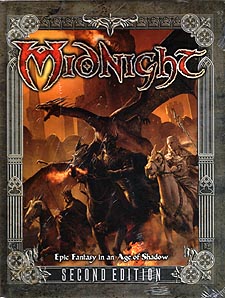Solitaire Gaming

I blame the whole thing on John O’Neill.
A few years back I asked him about the solo Dark City Games adventures that Andrew Zimmerman Jones and Todd McCaulty had reviewed so favorably for Black Gate. John happens to have a larger game collection than most game stores, so I’d come to the right person.
Solo games were great fun, John told me. “Here’s an extra copy of an old game you’ve never heard of that’s really cool. Go play it.”
That was Barbarian Prince. And yeah, it was pretty nifty (you can try it out yourself with a free download here, along with its sister solitaire product, Star Smuggler).
I started playing and enjoying the products created by Dark City Games, which the rest of the staff and I have continued to review for the magazine.
 But what are these solitaire games like?
But what are these solitaire games like?
The most obvious analogy is to say that solitaire games are a little like computer adventure games played with paper, with dice and cards taking the place of a computer game’s invisible randomization of results.
My first thought was something along the lines of “how quaint,” but it turns out that while the play experiences are similar, the flavors are slightly different, even if playing them stimulates similar centers of the brain.
It’s like switching off orange pop to try some root beer, or vice versa. You may not drink one or the other exclusively, but they both sure are sweet on a hot day.

While playing a solitaire game you may not see any computer graphics, but your imagination will paint some images for you.
And there’s the tactile pleasure of manipulating the counters and looking over the game board and flipping through the booklet and rolling the dice.
Solitaire in no way means that you will get the same game play each time, and to my surprise I’ve discovered that a well designed solo board game has better replay value than many computer games.






 I’m an old TSR module fan, and as such I’ve always been intrigued by how the concept of such media came into existence. For the most part they fall in series, kind of like writers follow Tolkien with the concept of connected books and characters in a trilogy. It makes perfect sense, especially if you’re trying to create an extended campaign with a gaming group that meets on a regular basis. Series modules facilitate that, and recently I had the opportunity to chat with one of the original designers of a TSR foundation adventure path, the L Series ‘Lendore Isles.’
I’m an old TSR module fan, and as such I’ve always been intrigued by how the concept of such media came into existence. For the most part they fall in series, kind of like writers follow Tolkien with the concept of connected books and characters in a trilogy. It makes perfect sense, especially if you’re trying to create an extended campaign with a gaming group that meets on a regular basis. Series modules facilitate that, and recently I had the opportunity to chat with one of the original designers of a TSR foundation adventure path, the L Series ‘Lendore Isles.’
 “Imagine if Frodo had died during his journey and the One Ring had returned to Sauron.”
“Imagine if Frodo had died during his journey and the One Ring had returned to Sauron.”